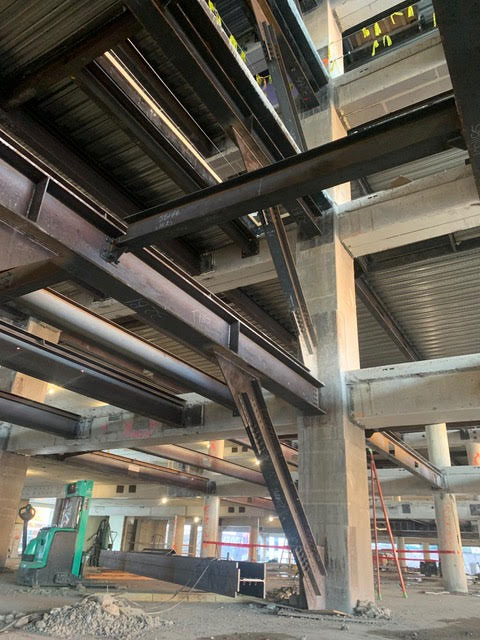A Number and a Story

Photo courtesy of 600 Fifth
Figure 3. Rendering of 600 Fifth Street NW, Washington, D.C., on completion, with four new steel-framed floors added to an existing eight-story commercial building.

Photo courtesy of Thornton Tomasetti
Figure 4. Steel bracing added to the existing concrete frame at 600 Fifth Street NW.
The team achieved carbon-footprint savings by retaining most of the existing structure (removing the concrete roof), adding floor area and terraces with steel framing, and incorporating supplemental steel framing and fiberglass-reinforced plastic where needed for strengthening. A series of steel braces supplemented the existing lateral system, tuned to meet stiffness and strength requirements without exceeding the existing foundation’s capacities. Existing pile testing was conducted to justify increased capacity of the existing foundations, which required no strengthening. “The goal was to use as much of the existing building’s capacity as possible and add structure only where necessary,” Cropper recalls.
The revamped building will have open-air terraces on every other floor, a shared tenant amenity space on the 12th floor, and a public ground-level park. Energy-efficient features include a new curtain wall and a dedicated outdoor air system with Minimum Efficiency Reporting Value 13-or-greater air filters providing 100 percent fresh air. The new 400,000-square-foot building, on track to earn LEED Gold and WELL ratings, topped out last May and is 50 percent preleased at this writing, anticipating a 2026 delivery date.
Laurel Christensen Chądzyński, sustainable design leader at Dyer Brown and Associates in Boston and director of engagement for the nonprofit organization Mindful Materials, sees parallels between material-reduction efforts and the Lean manufacturing philosophy (derived from Toyota Motor Corporation’s kaizen team system), which defines any element of a work-flow process that is not valuable to end-users as waste and targets it for elimination. Applying such a process to the elements of architectural EC, she notes, may take straightforward forms like preferring locally produced materials to minimize shipping, all other factors being equal, though reducible energy and carbon may not always appear economically visible. “The carbon impact is still an externality; there’s not a fee for a higher-carbon material,” she says. “We’re at the stage in the market where for many products, you’re still paying a green tax for a lower-embodied-carbon material. So if anything, I think owners might be hesitant to embrace those lower-embodied-carbon options, unless it’s already a priority to them to lower their carbon footprint on a given project.”
Chądzyński points to the ECHO Project (on the verge of publishing public-facing documents at this writing) as a step toward resolving certain persistent anomalies in carbon-data reporting. At a recent event in Boston, she recalls a presenter discussing a building with a noticeable “discrepancy between what was modeled and what actually was delivered to the site... they had modeled a 16 percent reduction in embodied carbon for the overall project, and what they ended up getting was 6 percent.” Such differences between modeling and execution, she observes, are frequent enough to require organized attention; more communication about such cases is a key step toward bringing modeled and measured figures closer. Considering “the variability in the aggregate and the mix of concrete” from local suppliers, compared with steel delivered from a consistent source, she adds, she would expect “less of a discrepancy between what’s modeled and what’s delivered” with steel structures.
Riffing on past AIA president Carl Elefante’s widely quoted observation that the greenest building is the one that’s already built, Chądzyński offers the corollary that “the lowest-embodied-carbon material is the one that’s already on site.” Since her firm often works on existing buildings and is the on-call architect for upgrades to some 75 buildings in downtown Boston, where the average lifespan of a corporate office interior is five to seven years, she and her colleagues use EC measurements (from the EC3 database and the Revit plugin Tally) to show clients the scale of the offset between repurposing and demolishing materials at the end-of-life stage for a building or space. “If we’re not able to keep existing material in place,” she adds, “we try to partner wherever possible with manufacturers who have take-back programs and coordinate with them to reclaim the material.” After another project where an effort to reclaim and repurpose materials from a renovated office interior was stymied by contractual and timing considerations, she says, “we realized we have to start these conversations way earlier,” leading to “growth of a huge network here in Boston that’s focused on material reuse as a way to reduce embodied carbon.” She headed a CLF/Dyer Brown/Structure Tone/Mass Design Group team that produced the Boston Deconstruction and Material Reuse Roadmap (Christensen et al.).
EC is not the sole consideration in a project, she acknowledges, recommending that anyone responsible for material choices consider “the concept of regrettable substitutions,” where an undesirable material is replaced by one that has been less thoroughly studied and may be toxic in ways not yet understood. “Carbon is massively important, but there’s also a huge need for supply-chain transparency so that we know that we don’t have forced labor in the supply chain [or unknown] human-health impacts upstream and downstream, not just in the installation phase but the ecosystem impact.”









